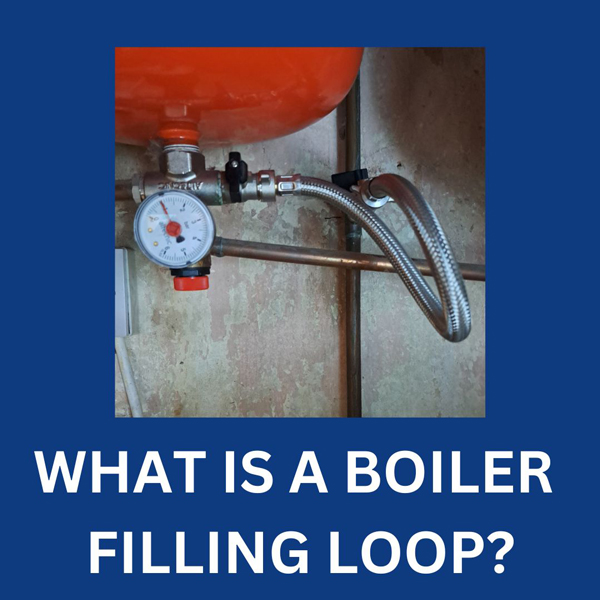
What is a Boiler Filling Loop? A Boiler filling loop connects the central heating system to the mains water supply. It’s used to repressurise the Boiler/central heating system if the pressure drops below the required level (usually 1-2 bar).
The Boiler Filling Loop Explained
A Boiler filling loop is vital to any central heating system. It comprises a short, flexible hose with one or two isolation valves at either end. This simple kit connects your central heating system to the mains water supply, allowing you to top up the system’s water level when the pressure drops too low.
Boilers must operate within a specific pressure range (usually 1-2 bar) for optimal performance. When the pressure drops below this range, it can lead to inefficient heating or stop the Boiler from running. The filling loop restores the pressure and keeps your Boiler running smoothly.
How Does A Boiler Filling Loop Work?
A Boiler filling loop allows you to manually add water to your heating system when the pressure is low. Here’s how it works:
- The flexible hose, part of the filling loop, connects the central heating system and your household’s main water supply.
- When the pressure drops below the recommended level (typically indicated on a gauge on the front of your Boiler), you can use the filling loop to introduce more water into the system.
- Opening the valves on the loop allows water to flow from the mains into the system, increasing the pressure to a safe level. Once this is achieved, the valves are closed.
Monitoring the pressure gauge while filling is important to ensure the Boiler is not over-pressurised. Overfilling can cause damage to the Boiler.
When Should You Use The Boiler Filling Loop?
One of the most common reasons for low pressure in a Boiler system is water loss through small leaks or after bleeding your radiators. Low pressure can lead to various issues, such as:
- Radiators are not heating up properly.
- Inconsistent heating throughout your home.
- The Boiler shutting down.
If you notice any of these symptoms, the first thing to check is the pressure gauge on your Boiler. Most Boilers operate at a pressure level between 1 and 1.5 bar. If the gauge reads below 1, it’s time to use the Boiler filling loop.
The gauge may drop for various reasons, including the natural air release from the system, small leaks, or after bleeding radiators. In these instances, using the filling loop to restore pressure is a straightforward solution.
How To Use A Boiler Filling Loop
Here’s a simple step-by-step guide on how to safely use a Boiler filling loop:
- Locate the filling loop: This is typically found beneath the Boiler, which is a silver flexible hose with one or two valves.
- Check the pressure gauge: Before adding water, check the Boiler’s pressure using the gauge on the front panel. If it reads below 1 bar, you’ll need to increase the pressure.
- Open the valves: Turn the valves on the filling loop to allow water from the mains to enter the system. Keep an eye on the pressure gauge.
- Watch the pressure rise: As you open the valves, you’ll see the pressure gauge rise. Turn off the valves once they reach the recommended range (consult your Boiler manual. It’s usually between 1 and 1.5 bar).
- Close the valves and remove the loop: Once the pressure is at the correct level, close the valves fully.
Maintaining Boiler Pressure
While topping the pressure with a filling loop is relatively simple, it shouldn’t be needed too frequently. If you find that you’re having to top up your Boiler often, it could be a sign of a deeper issue, such as:
- A leak in the system.
- Problems with the Boiler’s pressure relief valve.
- Issues with the expansion vessel.
In such cases, it’s best to consult a qualified heating engineer to inspect your system and resolve any underlying problems. Additionally, always refer to the Boiler’s manual for specific instructions.
Checking your Boiler’s pressure will help you avoid sudden pressure drops and ensure your system continues to run efficiently. It’s a good practice to check the gauge every few months, especially during winter when the heating system is used regularly.
Do All Boilers Have Filling Loops?
Not all Boilers—whether combi, system, or heat-only—have filling loops as part of their standard setup, but many do, especially in modern installations. Here’s a breakdown of how filling loops are generally associated with each type of Boiler:
Combi Boilers
Combi Boilers provide hot water directly from the mains without needing a separate water cylinder or storage tank. Combi Boiler systems are sealed, requiring the correct pressure to run properly. , A filling loop is necessary to top up the water and maintain the right pressure.
System Boilers
System Boiler central heating systems use a hot water cylinder (but no cold water tank) and are also sealed systems. As with combi Boilers, they need a certain pressure level to work correctly. Most system Boilers have a filling loop to manually adjust the system pressure if it drops.
Heat-Only Boilers (Regular Boilers)
Heat-only Boilers, also known as regular or traditional Boilers, work differently from combi and system Boilers. They rely on a cold water storage tank and a feed and expansion tank, usually located in the loft, which maintains the water level in the system. Since these are open-vented systems, the system pressure is maintained by the tanks rather than through direct mains pressure. Therefore, heat-only Boilers typically do not require a filling loop. The tanks provide the water needed for the system to operate, so pressure loss isn’t an issue as it is with sealed systems.
When To Call A Professional
While using a Boiler filling loop is straightforward, certain situations may require professional assistance. If your Boiler continues to lose pressure after frequent topping up, this could indicate a serious issue that needs expert attention.
Additionally, if you’re unsure how to use the filling loop or feel uncomfortable handling Boiler pressure, it’s always safer to call a qualified Boiler engineer. They will top up the system for you and inspect the Boiler for potential faults.
If you live in Essex and need help with your filling loop, repressurising your Boiler or anything else please get in touch with us and speak to one of our heating engineers.

Hi, I’m Terry, the founder and owner of TM Hughes & Son Gas Services
Please get in touch to book an appointment or receive a free, no-obligation quote
Call – 01245 830075
Email – info@tmhughesandson.uk
Get A Free Boiler Quote
0% Finance
For Boiler Installations
